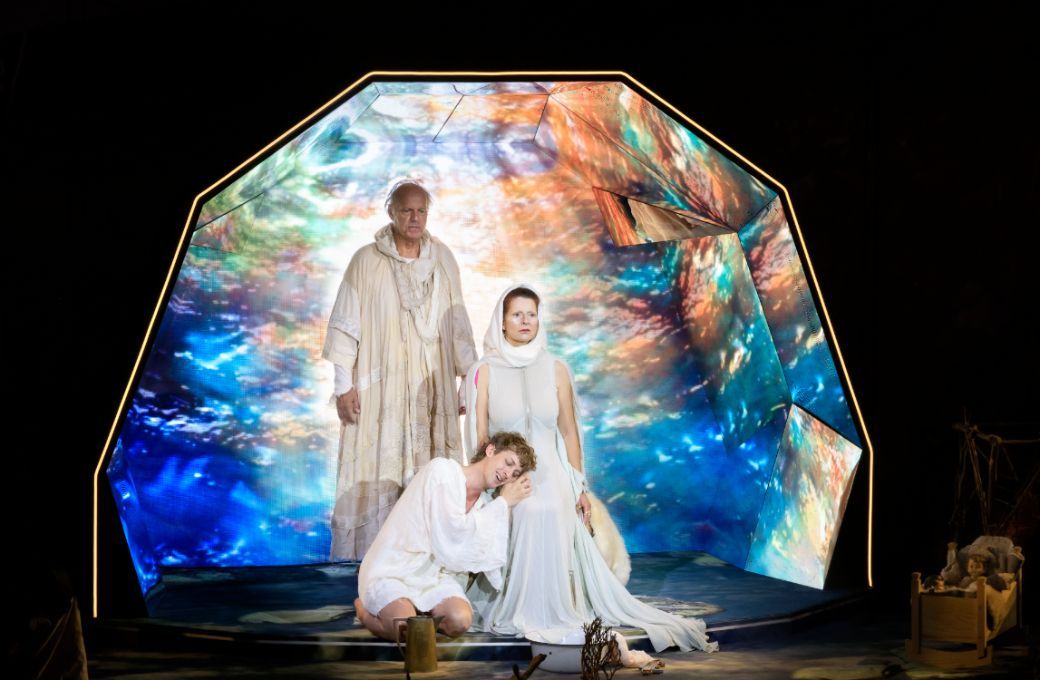Whatever you say about Wagner’s final music drama, naturalist drama it ain’t. The characters in Parsifal exist in a world of myth that’s impossibly distant to ours, and any director who stages the work has to deal with that challenge. For this production for Opera Ballet Vlaanderen, the approach of director Susanne Kennedy and her scenographic collaborator Markus Selg is to go to the extremes of symbol and ritual, stripping from the characters almost anything that makes them relatable and turning them into pure images.

The most obvious way they do this is through extensive use of digital projections which flood the stage for the entire evening. Sometimes these are abstract patterns which are often beautiful as they shift like a rotating kaleidoscope, or they can be repeating symbols like a journey through a tunnel that never quite reaches the light, although they’re less successful when they represent real things: the birds and animal look like they could have escaped from a video game in the late 1990s. The effect, however, is to make the action on stage seem even more distant and remote than usual, placing it in a parallel universe of symbolism which is often baffling to decode.
Kennedy’s direction of the singers is minimal. Nearly everyone is already on stage at the start of Act 1, rooted to a spot from which they barely move, and the little action that Wagner mandates is replaced by stasis and stylised movement, with repeated arm gestures that suggest something ritualistic but don’t tell us anything about the characters, their motivations or the underlying meaning of the ritual. These alienate the viewer from the characters and get in the way, literally so in the case of six gesticulating handmaids at the front of the stage who obstruct the Parsifal-Kundry duet of Act 2, the most animated thing in the staging.
But if the production lacks urgency then the musical consolations were considerable. American Heldentenor Christopher Sokolowski was a hugely impressive Parsifal, convincingly young and handsome, for once, but with a baritonal edge to his voice that lent it power and a touch of grandeur. Kartal Karagedik was a sensational Amfortas, one of the finest I’ve heard. He was vigorous, energetic and impassioned, hounded by his guilt, a young man whose best years have been stolen by his wound, thus making him all the more sympathetic. Dshamilja Kaiser began as a mezzo-ish Kundry, but she thrilled in the big Act 2 duet, letting rip at the top of her register exactly when needed. Albert Dohmen repeatedly ran out of puff as Gurnemanz, and his delivery of the Good Friday Music, in particular, was uncomfortably staccato, although you couldn’t deny the gravitas in the voice.
Finest of all, however, the orchestra of Opera Ballet Vlaanderen played the score with subtlety and transparency, making it glow in the setting. It reminded me of what the piece sounded like at Glyndebourne because, despite its grand façade, Opera Vlaanderen Antwerp is a smallish theatre, and the intimacy of the setting made for the most humane-sounding Wagner imaginable. They also used it imaginatively, placing the women and children’s choruses at the top of the auditorium in the Grail scenes, to spine-tingling effect. Conductor Alejo Pérez is a self-described “Wagner fanatic”, and he kept things moving forward persuasively, deploying the different components of his orchestral palette to gorgeous effect by the third act, which sounded luminous, weightless and enormously satisfying.


